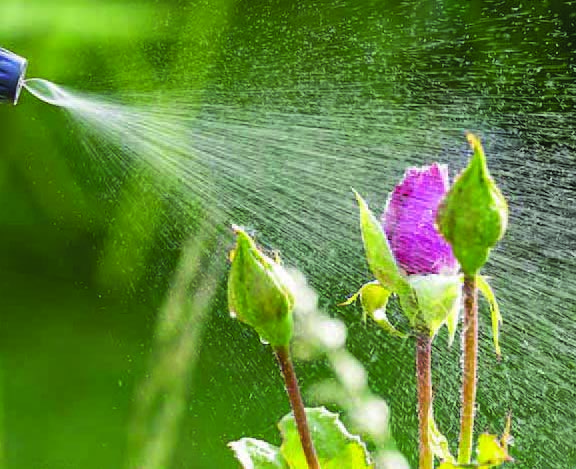
Resistance to pesticides, in this case, insecticides and miticides, is a change in the sensitivity of an insect or mite pest population that’s reflected in the failure of a pesticide to manage insect or mite pest populations below plant-damaging levels when used according to label directions.
Resistance is the genetic ability of some individuals in an insect or mite pest population to survive an application or applications of pesticides.
Resistance to pesticides, in this case, insecticides and miticides, is a change in the sensitivity of an insect or mite pest population that’s reflected in the failure of a pesticide to manage insect or mite pest populations below plant-damaging levels when used according to label directions. Resistance is the genetic ability of some individuals in an insect or mite pest population to survive an application or applications of pesticides.
In addition, the pesticide no longer effectively kills enough individuals in an insect and/or mite pest population to prevent plant damage.
Pesticide resistance
Pesticide selection, rate and application frequency are the main factors that promote resistance developing in insect and mite pest populations. The selection pressure placed on insect and/or mite pest populations when applying pesticides influences resistance. High reproductive capacity and multiple generations (the time required to complete all life stages within a life cycle) contribute to enhancing selection pressure. In addition, insect and mite pests with short generation times generally develop resistance faster than insect and mite pests with longer generation times.
Temperature can influence the ability of insect and mite pests to develop resistance. For instance, temperatures greater than 70°F (20.9C) may result in the occurrence of many generations during the growing season, thus leading to more pesticide applications and the rapid selection for resistant individuals. Furthermore, off-label use or not using recommended label rates can promote the development of resistance.
Application rate and residual activity on plant leaves can influence selection pressure and the likelihood of resistance development. However, insufficient management of insect and/or mite pest populations may be incorrectly attributed to pesticide resistance. For example, other factors can affect the management of insect and/or mite pest populations below plant-damaging levels, such as not using the correct pesticide, not using the correct label rate and not thoroughly covering all plant parts with a spray solution.
Applying pesticides at the appropriate time can delay pesticide resistance by reducing selection pressure, which can lead to effective management of insect and mite pests as long as the insect and mite pest population isn’t resistant to the pesticide. Moreover, rotating pesticides with different modes of action is the most effective resistance management strategy because rotating discrete modes of action avoids exposing consecutive generations of an insect or mite pest population to pesticides with similar modes of action.
Insect & mite biological parameters
It’s important to understand the biology, ecology and feeding behavior of insect and mite pests to enhance the effectiveness of pesticide applications. The cryptic feeding behavior of adults and larvae and rapid development time of the life cycle (egg to adult) are important factors that influence the effectiveness of pesticide applications. When applying a pesticide, you need to target the most susceptible life stage of the insect and/or mite pest.
For example, pesticides are ineffective when not applied when susceptible life stages (larvae, nymph, or adult) of an insect or mite pest are present. Different life stages may vary in their susceptibility to pesticides. In general, larvae are less susceptible to pesticides as they age and increase in size. In addition, larval behavior can influence the effectiveness of pesticide applications. Larvae that feed inside plant tissues (e.g., buds, flowers, or fruits) reduce their exposure to contact insecticides because the larvae are protected from spray applications, which reduces the number of larvae that are killed. Also, larvae feeding in the lower portions of the plant canopy may avoid/escape exposure from pesticide spray applications.
Pesticide application
Improper calibration or maintenance of spray equipment can result in insufficient management of insect and mite pest populations with pesticides. Spray distribution and deposition can differ depending on the type of application equipment, which can result in varying coverage of plant parts (e.g. leaf undersides), leading to few insect and/or mite pests being killed from the application.
Droplet size, number and distribution can influence the ability to manage insect and mite pest populations below plant-damaging levels. For instance, the mortality of larvae is higher when exposed to small droplet sizes compared to exposure to large droplet sizes. Differences in the feeding behavior of larvae on leaves with small or large droplet sizes may lead to larvae encountering different rates of insecticides. For small droplet sizes, larvae encounter the insecticide by contact and ingestion, whereas exposure to large droplet sizes may result in larvae being exposed to sub-lethal concentrations.
Conclusions
Understanding pesticide resistance, especially when trying to manage multiple insect and/or mite pest species complexes, can affect rotation programs. In addition, it’s essential to know the biology and ecology of insect and/or mite pests to mitigate insect and/or mite pest populations developing resistance. Applying pesticides frequently to manage insect and/or mite pests without considering the generation time can result in successive generations exposed to the active ingredient of pesticides having similar modes of action, which can enhance resistance development.
Written by Dr. Raymond A. Cloyd who is a Professor and Extension Specialist in Horticultural Entomology/Plant Protection at Kansas State University in Manhattan, Kansas.
